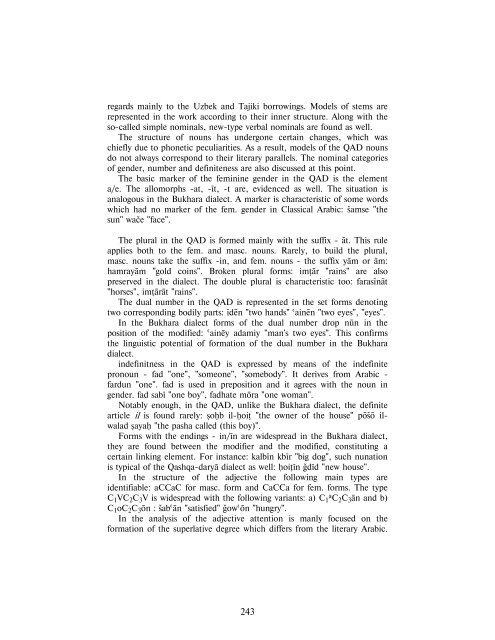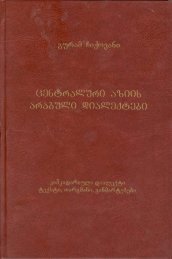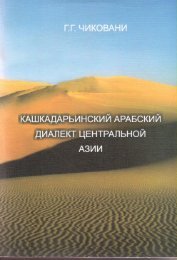Create successful ePaper yourself
Turn your PDF publications into a flip-book with our unique Google optimized e-Paper software.
egards mainly to the Uzbek and Tajiki borrowings. Models of stems are<br />
represented in the work according to their inner structure. Along with the<br />
so-called simple nominals, new-type verbal nominals are found as well.<br />
The structure of nouns has undergone certain changes, which was<br />
chiefly due to phonetic peculiarities. As a result, models of the QAD nouns<br />
do not always correspond to their literary parallels. The nominal categories<br />
of gender, number and definiteness are also discussed at this point.<br />
The basic marker of the feminine gender in the QAD is the element<br />
a/e. The allomorphs -at, -×t, -t are, evidenced as well. The situation is<br />
analogous in the Bukhara dialect. A marker is characteristic of some words<br />
which had no marker of the fem. gender in Classical Arabic: âamse "the<br />
sun" waÉe "face".<br />
The plural in the QAD is formed mainly with the suffix - Át. This rule<br />
applies both to the fem. and masc. nouns. Rarely, to build the plural,<br />
masc. nouns take the suffix -in, and fem. nouns - the suffix yÁm or Ám:<br />
hamrayÁm "gold coins". Broken plural forms: imãÁr "rains" are also<br />
preserved in the dialect. The double plural is characteristic too: faras×nÁt<br />
"horses", imãÁrÁt "rains".<br />
The dual number in the QAD is represented in the set forms denoting<br />
two corresponding bodily parts: ×dÎn "two hands" ÷ainÎn "two eyes", "eyes".<br />
In the Bukhara dialect forms of the dual number drop næn in the<br />
position of the modified: ÷ainÎy adamiy "man's two eyes". This confirms<br />
the linguistic potential of formation of the dual number in the Bukhara<br />
dialect.<br />
indefinitness in the QAD is expressed by means of the indefinite<br />
pronoun - fad "one", "someone", "somebody". It derives from Arabic -<br />
fardun "one". fad is used in preposition and it agrees with the noun in<br />
gender. fad sab× "one boy", fadhate mÝra "one woman".<br />
Notably enough, in the QAD, unlike the Bukhara dialect, the definite<br />
article il is found rarely: áoÔb il-Ôoiã "the owner of the house" pÝâÝ ilwalad<br />
áayaÔ "the pasha called (this boy)".<br />
Forms with the endings - in/×n are widespread in the Bukhara dialect,<br />
they are found between the modifier and the modified, constituting a<br />
certain linking element. For instance: kalb×n kb×r "big dog", such nunation<br />
is typical of the Qashqa-daryÁ dialect as well: Ôoiã×n Ód×d "new house".<br />
In the structure of the adjective the following main types are<br />
identifiable: aCCaC for masc. form and CaCCa for fem. forms. The type<br />
C1VC2C3V is widespread with the following variants: a) C1 a C2C3Án and b)<br />
C1oC2C3Ýn : âab÷Án "satisfied" Óow÷Ýn "hungry".<br />
In the analysis of the adjective attention is manly focused on the<br />
formation of the superlative degree which differs from the literary Arabic.<br />
243





